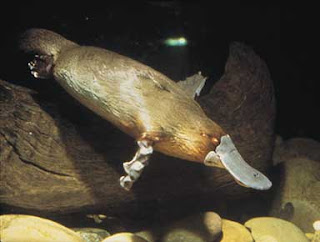Weird creatures and animals are common in Australia a recent photo posted on facebook is of a small hairless creature caught in a trap.
According to locals in the town of Quilpie in Outback Queensland it was accidentally caught by a farmer in a wild dog trap (Wild dogs are big problem to livestock in Western areas of Queensland).Locals say that these are just a species of hairless possums that are common to the area and have been sighted many times by locals during the night as like most possums they are Nocturnal.
Local aborigines are known to fear them and call them Devil Ghosts.

Local National Parks and wildlife rangers are investigating the area, and believe the photo is more than likely not fake, and is likely to be a possum with some kind of skin disorder, as certain times of year the sand flies in the area are thick, and cause skin diseases that can cause animals to lose their hair and have been known in the past to have killed thousands of Kangaroos and wildlife in the outback.
A supposedly tailless, five-foot tall ape photographed in Venezuela by François de Loys, a Swiss geologist, sometime around 1920. The picture caused an uproar in the scientific community, because only monkeys, not apes, are believed to inhabit the Americas. If genuine, the finding of such an ape would have thrown into confusion the accepted theory of primate evolution.
Yowies is the term for an unidentified hominid reputed to lurk in the Australian wilderness. It is an Australian crypt id similar to the Himalayan Yeti and the North American Bigfoot
Yowies according to the Aborigines, the sounds emitted by these 'hairy people' varies from grunts to howling. They wandered the remoter forest regions of the eastern mountains ranges, often in small family groups, sometimes in pairs or singularly, sleeping in caves, rock overhangs or in open forest depending upon weather conditions.
Old Bungaree a Gunedah aboriginal ...said at one time there were tribes of them [yahoos] and they were the original inhabitants of the country-he said they were the old race of blacks... [The yahoos] and the blacks used to fight and the blacks always beat them but the yahoo always made away...being...faster runners.
Yowies were first sighted by a white man was released in the local Newspapers in a small country town we now know as Sydney. During the 1800's numerous reports followed through out NSW and also the rest of the country. The 1800's were a buzz with sightings of the creature around the country. Newspapers and magazines began writing about people's encounters as they were reported. In most of these reports, the creature was always described as "an ape" or "ape-like man." The same descriptions given today.
One such beast, was reported in a Sydney newspaper, to have been caught and taken back to England
and sold to a Yorkshire circus for 2000 pound
For 25 years, Rex Gilroy has trekked some of Australia's most rugged country in his search for the Yowie, or Great Hairy man.
Yowies research has shown, there are at least two known kinds of Yowie in Australia. There are the large Yowies that is normally between 6-10ft and the smaller, yet fully-grown variety that is roughly 4-5ft.
















































